"Currently, there are 30,000 out-of-hospital cardiac arrests each year in the UK. The survival rates for victims are incredibly low; it is estimated less than 1 in 10 victims survive."
It can happen anywhere anytime.
It can happen to you, to your friends/family...
But do you know what to do?
Cardio Pulmonar Ressucitation
Please take a moment to learn how to perform CPR, it saves lives.
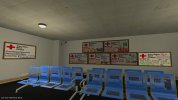
STEP 1: Secure the environment. Why is the victim unconscious? What happened to them?
Make sure the environment is safe, we don't want two victims. Mind the smoke/fire/electric/biological/etc hazards.
Example: In a RTC, you can easily get run over by incoming traffic so it's advisable to block the lane with your car/ambulance.

STEP 2: Stay with the victim and shout for help. Have someone call 911 and if possible get an AED
(automated external defibrillator)
The sooner we call 911, the sooner the victim will receive medical attention. It is important to have someone do it so we can quickly begin CPR.
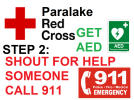
STEP 3: Check consciousness. Maybe the victim is just having a nap?
We will try to get a response from the unconscious person by:
1) Yelling out loud while shaking them (If no traumatic injuries are suspected): "HELLO! CAN YOU HEAR ME?" "HEY!" "ARE YOU OK?"
-If the victim does not respond:
2) We will cause pain by twisting the victims skin or rubbing our fist against their chest.
-If the victim does not respond:
3) Go to STEP 4
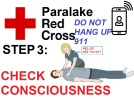
STEP 4: The victim did not respond to any kind of stimuli so we will make sure they are still alive:
We check for breathing by placing our ear next to the victim's mouth while at the same time having a clear sight of their chest, checking for any breathing in/out movement. (Chest goes up and down)
TO DO THIS: We will perform the head-tilt-chin-lift maneuver to prevent the victim's tongue from blocking the airway.
BUT NOT: If we suspect traumatic injuries. (Example: Car accident/fall/fight/etc...)

STEP 5: Begin CPR: 30 compressions + 2 breaths.
1)Cross your fingers, and extend your arms firmly while holding yourself onto the victim's chest (Exactly between the nipples) and push 30 times (up/down) with a constant rhythm (2 compressions per second) ALL THE WAY DOWN.
Don't worry about the ribs. While compressing you're moving blood around their body and keeping them ALIVE!
2) Count 30 compressions and then quickly give 2 breaths. And restart compressions.
It is advisable to have a pocket CPR mask to prevent contagious diseases so it's up to you wether you want to ventilate or not if you don't have any means to protect yourself, such as an Ambu® bag-valve-mask.
>If available, place AED electrodes.
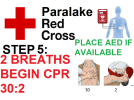
STEP 6: Do not stop CPR (30-2). If exhausted, ask someone else to take over.
If an AED is available, and electrodes were placed, follow the device's voice prompts such as:
"ANALYZING RHYTHM STOP COMPRESSIONS"
"CONTINUE COMPRESSIONS"
"SHOCK IS RECOMMENDED"
"SHOCK IS NOT RECOMMENDED"
"CHARGING..."
"DO NOT TOUCH THE PATIENT: DEPLOYING SHOCK."
IMPORTANT If someone is touching the victim while the AED is shocking the victim they will also receive an electric shock and DIE. (As their heart will be reset aswell.)
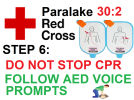
Wait for EMS to arrive and take care of the victim and keep 911 on the speaker phone if possible. Never hang up.
Protocols keep changing as scientific evidence is obtained. You can stay updated by following ILCOR's updates.
This guide was written by a certified EMS professional with love for PERPHEADS.COM.
I hope you enjoyed this guide and that it saves someones life some day.
-Alex
It can happen anywhere anytime.
It can happen to you, to your friends/family...
But do you know what to do?
Cardio Pulmonar Ressucitation
Please take a moment to learn how to perform CPR, it saves lives.

STEP 1: Secure the environment. Why is the victim unconscious? What happened to them?
Make sure the environment is safe, we don't want two victims. Mind the smoke/fire/electric/biological/etc hazards.
Example: In a RTC, you can easily get run over by incoming traffic so it's advisable to block the lane with your car/ambulance.

STEP 2: Stay with the victim and shout for help. Have someone call 911 and if possible get an AED
(automated external defibrillator)
The sooner we call 911, the sooner the victim will receive medical attention. It is important to have someone do it so we can quickly begin CPR.

STEP 3: Check consciousness. Maybe the victim is just having a nap?
We will try to get a response from the unconscious person by:
1) Yelling out loud while shaking them (If no traumatic injuries are suspected): "HELLO! CAN YOU HEAR ME?" "HEY!" "ARE YOU OK?"
-If the victim does not respond:
2) We will cause pain by twisting the victims skin or rubbing our fist against their chest.
-If the victim does not respond:
3) Go to STEP 4

STEP 4: The victim did not respond to any kind of stimuli so we will make sure they are still alive:
We check for breathing by placing our ear next to the victim's mouth while at the same time having a clear sight of their chest, checking for any breathing in/out movement. (Chest goes up and down)
TO DO THIS: We will perform the head-tilt-chin-lift maneuver to prevent the victim's tongue from blocking the airway.
BUT NOT: If we suspect traumatic injuries. (Example: Car accident/fall/fight/etc...)

STEP 5: Begin CPR: 30 compressions + 2 breaths.
1)Cross your fingers, and extend your arms firmly while holding yourself onto the victim's chest (Exactly between the nipples) and push 30 times (up/down) with a constant rhythm (2 compressions per second) ALL THE WAY DOWN.
Don't worry about the ribs. While compressing you're moving blood around their body and keeping them ALIVE!
2) Count 30 compressions and then quickly give 2 breaths. And restart compressions.
It is advisable to have a pocket CPR mask to prevent contagious diseases so it's up to you wether you want to ventilate or not if you don't have any means to protect yourself, such as an Ambu® bag-valve-mask.
>If available, place AED electrodes.

STEP 6: Do not stop CPR (30-2). If exhausted, ask someone else to take over.
If an AED is available, and electrodes were placed, follow the device's voice prompts such as:
"ANALYZING RHYTHM STOP COMPRESSIONS"
"CONTINUE COMPRESSIONS"
"SHOCK IS RECOMMENDED"
"SHOCK IS NOT RECOMMENDED"
"CHARGING..."
"DO NOT TOUCH THE PATIENT: DEPLOYING SHOCK."
IMPORTANT If someone is touching the victim while the AED is shocking the victim they will also receive an electric shock and DIE. (As their heart will be reset aswell.)

Wait for EMS to arrive and take care of the victim and keep 911 on the speaker phone if possible. Never hang up.
Protocols keep changing as scientific evidence is obtained. You can stay updated by following ILCOR's updates.
This guide was written by a certified EMS professional with love for PERPHEADS.COM.
I hope you enjoyed this guide and that it saves someones life some day.
-Alex
Last edited:







